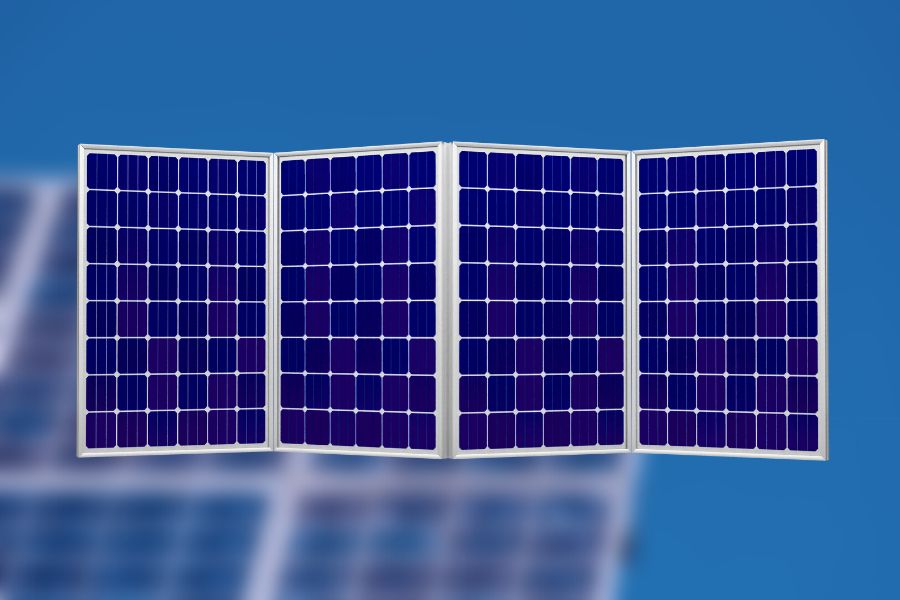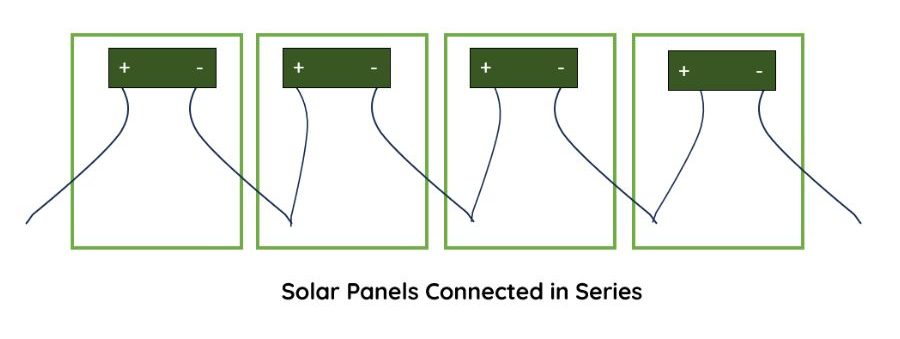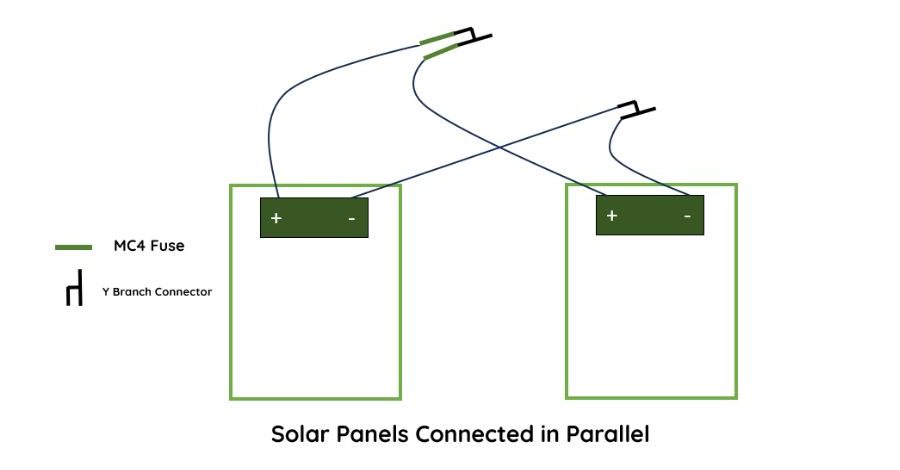Solar Panel Series and Parallel Calculator
Updated:

Solar panel series and parallel calculator the wattage of a solar array in series, parallel, and series-parallel configs. This way, you can readily tell the optimal configuration for your solar power system.
Some solar panels in series will generate more power than when they have parallel wiring. Contrarily, others have higher output when in parallel.
How to Use the Calculator
- Enter the rated voltage of the solar panels at maximum power in the “Max Power Voltage (Vmp)” field. You should find this value on the pack, spec sheet, or the back of the solar panel. It would be written as Vmp, Vmpp, maximum power voltage, or maximum power point voltage.
- Enter the rated current of the solar panels at maximum power in the “Max Power Current (Imp)” field. This should also be in the spec sheet, on the pack, or at the back of the solar panel. It would be written as Imp, Impp, maximum power current, or maximum power point current.
- If you’re using identical solar panels, enter how many solar panels have the preceding Vmp and Imp ratings in the “Quantity” field. For instance, if 5 solar panels have the same Vmp and Imp, enter 5 in the “Quantity” field.
- If some solar panels have different Vmp and Imp, click on the “+ Add a Panel” button to add each unidentical solar panel. Then enter the maximum power voltage and maximum power current of each one.
- After inputting the max power voltage and current of the panels of the solar PV system, click on Calculate. To get the results.
- Suppose all the solar panels are the same. In that case, the calculator will return the values of maximum power output, maximum power voltage (Vmp), maximum power current (Imp), and power loss for all solar panels’ series and parallel wiring.
- However, use different solar panels in addition to the above. The calculator will return values for maximum power output, maximum power voltage, maximum power current, and power loss for series-parallel wiring and parallel-series wiring configurations.
This calculator will not compute your solar array’s maximum open circuit voltage.
You’ll need an open circuit voltage to determine the maximum operating voltage of the charge controller for the system.
You may also need open circuit voltage to determine the maximum operating voltage of the inverter for your solar power system.
How to Calculate Maximum Output Power for Solar Panels in Different Configurations

Identical Solar Panels Wired in Series
Wiring configurations alter the net voltage and current of a circuit. So, since power is a product of voltage and current, how we wire solar panels affects the power output of solar panels.
When you wire solar panels in series, and the panels are identical, the total Vmp of the array would be the sum of the max power voltages of the individual modules.
But the total max power point current would be the average Imp of the panels (the average current is equal to the current of one solar panel).
So, the power of an array of identical panels in series would be:
power = total max power voltage of each PV module x average Impp of the solar panels
Example
If we connect four solar panels with a max power point voltage of 15.66V and a max power point current of 3.45A, what would be the total power output of the array?
First, we’ll calculate the total volts of the array:
\(= 15.66 + 15.66 + 15.66 + 15.66 = 62.64V\)
Or better still:
\(= 15.66 * 4 = 62.64V\)
Now, we can calculate the total wattage:
\(= 62.64 * 3.45 = 216.1W\)
You’ll get the same result if you try this example with our solar panel calculator.
Identical Solar panels Wired in Parallel
For identical panels in parallel, the total max power voltage is the average power voltage of the panels (the average voltage is equal to the voltage of one solar panel).
However, the total max power current is the sum of the max power currents of all the PV modules in the array.
So, the power of an array of identical panels in parallel would be:
\(\begin{gather} power = average\ Vmpp\ of\ the\ solar\ panels * total\ max\ power\ current \\
of\ each\ PV\ module \end{gather}\)
Example
If we connect the solar panels in the previous example in parallel, what would be the total wattage of the PV array?
If you recall, the Vmp of each solar panel is 15.66V, and Imp is 3.45A.
We’ll start by calculating the total max power current of the array:
\(= 3.45 * 4 = 13.8A\)
Then we’ll calculate the max wattage point:
\(= 15.66 * 13.8 = 216.1W\)
As you may have noticed, the total power of the series and parallel configurations are the same. This is usually the case with identical solar panels.
Identical Solar Panel Series-Parallel Connection
Still using the four solar panels from the series connection:
If we wire all four panels into two pairs of series connections, then wire those two pairs in parallel, we’ll have a series-parallel config. But would the max power of the solar array be different? Let’s see.
So, we have two sets of two panels in a series. The total max power voltage of each two-panel series would be:
\(= 15.66 * 2 = 31.32V\)
Then max power current of each two-panel series would be 3.45A. So, in the parallel config, each component would be 31.32V, 3.45A.
Remember, in parallel configurations of identical solar panels, the max power voltage is the average voltage of the components.
So, the max power voltage of the array would be 31.32V. Then max power current is summative. So, the max power current of the array would be:
\(= 3.45 * 2 = 6.9A\)
Finally, the max power of the array would be:
\(= 31.32 * 6.9 = 216.1W\)
From the result, identical solar panels will most likely generate the same output, no matter their configuration.
Unidentical Solar Panels in Series
When working with mismatched solar panels in series, things are slightly different.
As usual, we’ll add up each solar panel’s max power point voltage.
However, the current we’ll use in calculating the max power would be the lowest current rating of all solar panels in the system instead of the average. For this reason, there will be power loss.
So, the power of an array of unidentical PV modules in a series would be:
\(\begin{gather} power = total\ max\ power\ voltage\ of\ each\ PV\ module * Impp\ of\ solar\ panel \\
with\ lowest\ current\ rating \end{gather}\)
Example
If we have four different solar panels with the following Vmp and Imp specifications, respectively:
- 12.3V, 2.34A
- 13.45V, 3.3A
- 15.26V, 2A
- 14.8V, 2.8A
What would be the max power in a series of these panels?
From the specifications, the lowest current rating is 2A. So, the Impp we’ll use in our calculation would be 2A.
The total max power voltage of the array would be:
\(= 12.3 + 13.45 + 15.26 + 14.8 = 55.81V\)
The max power of the array would be:
\(= 55.81 * 2 = 111.62W\)
Unidentical Solar Panels in Parallel
When connecting unidentical solar panels in parallel, the voltage would be the lowest voltage rating of every solar panel in the array. However, the current would be the sum of the max power current of each solar panel.
As with unidentical solar panels in series, there will be power loss here because we use the smallest voltage rating instead of the average.
So, the power of an array of unidentical PV modules in parallel would be:
power = total max power current of each PV module x Vmpp of solar panel with lowest voltage rating
Example
If we’re connecting the four solar panels in the previous example in parallel, what would be the max wattage of the array?
From the specifications, the lowest voltage is 12.3V. Then the total max power current is:
\(= 2.34 + 3.3 + 2 + 2.8 = 10.44A\)
The max power of the array would be:
\(= 10.44 * 12.3 = 128.41W\)
Comparing the series and parallel configurations, it appears that the parallel configuration offers more power than the series config in this case.
So, when connecting those four solar panels, we’ll connect them in parallel.
Unidentical Solar Panel Series-Parallel Connection
Using the four solar panels from above:
Say we connect the 12.3V, 2.34A & 13.45V, 3.3A in series and the 15.26V, 2A & 14.8V, 2.8A in series. Then we connect the resulting series arrays in parallel with an unidentical series-parallel configuration.
Let’s see how it affects the output.
The total volts in the first series array would be:
\(12.3 + 13.45 = 25.75V\)
Then the current would be 2.34A (the lower one).
The total volts in the second series array would be:
\(15.26 + 14.8 = 30.06V\)
Then the current would be 2A.
In the parallel config, we’ll have two arrays: 25.75V, 2.34A, and 30.06, 2A. So, the volts would be 25.75V. Then the current would be:
\(2.34 + 2 = 4.34A\)
So, the max power of the whole connection would be:
\(= 25.75 * 4.34 = 111.76W\)
The series-parallel config doesn’t give us as much power as the parallel config. But it offers slightly more power than the series config.
How to Connect Solar Panels in Serie

To connect solar modules in series, connect the negative terminal of one solar panel to the positive terminal beside it.
Repeat this until all the negative and positive terminals are connected, leaving one unconnected negative terminal and one unconnected positive terminal and either end of the array.
How to Connect Solar Panels in Parallel

You’ll need at least two branch connectors (typically a Y-branch) to connect solar panels in parallel. You may also need MC4 fuses for the positive terminal of each solar panel.
Once you have the connectors and fuses, do the following:
- Connect each positive terminal to an MC4 fuse. Then connect the MC4 fuses of each positive terminal to one Y branch connector.
- After that, connect the negative terminals to the other Y branch connector.
Wiring Solar Panels in Series or Parallel: Which Is Best?
The better option between both configurations is mainly dependent on the use case.
Series connection is better when:
- the solar panel system is usually unshaded
- the solar charge controller is MPPT
- you do not want extra costs
Parallel is better when:
- you are okay with extra costs
- the array gets a significant amount of shade
- the solar charge controller is PWM










